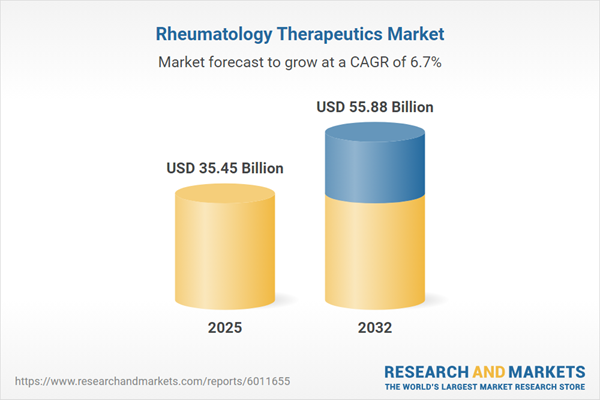Speak directly to the analyst to clarify any post sales queries you may have.
The rheumatology therapeutics market is undergoing significant transformation, driven by innovations in targeted therapies, evolving care models, and digital integration. This report equips senior stakeholders with critical insights to navigate a complex, high-growth landscape where precision medicine and value-based strategies are reshaping clinical and commercial outcomes.
Market Snapshot: Rheumatology Therapeutics Market Performance
The global rheumatology therapeutics market expanded from USD 33.24 billion in 2024 to USD 35.45 billion in 2025. Sustained by advancements in molecular medicine, competitive biosimilar adoption, and an expanding patient base, the market is projected to reach USD 55.88 billion by 2032 at a CAGR of 6.70%. Growth drivers include the shift to targeted biologics, increased prevalence of autoimmune disorders, and integration of digital health across care delivery.
Scope & Segmentation: Market Coverage and Strategic Axes
- Therapeutic Classes: Conventional disease-modifying antirheumatic drugs (hydroxychloroquine, leflunomide, methotrexate, sulfasalazine), IL-6 inhibitors, JAK inhibitors, TNF inhibitors.
- Molecule Types: Biologics, biosimilars, small molecules.
- Indications: Ankylosing spondylitis, gout, psoriatic arthritis, rheumatoid arthritis, systemic lupus erythematosus.
- Routes of Administration: Intravenous, oral, subcutaneous.
- Patient Age Groups: Adult, pediatric.
- Distribution Channels: Offline (hospital pharmacies, specialty clinics, physician offices), online (home delivery, digital adherence platforms).
- Regional Coverage: Americas (United States, Canada, Mexico, Brazil, Argentina, Chile, Colombia, Peru), Europe, Middle East & Africa (United Kingdom, Germany, France, Russia, Italy, Spain, Netherlands, Sweden, Poland, Switzerland, United Arab Emirates, Saudi Arabia, Qatar, Turkey, Israel, South Africa, Nigeria, Egypt, Kenya), Asia-Pacific (China, India, Japan, Australia, South Korea, Indonesia, Thailand, Malaysia, Singapore, Taiwan).
- Key Market Players: AbbVie Inc., Johnson & Johnson, Novartis AG, Roche Holding AG, Pfizer Inc., Amgen Inc., Eli Lilly and Company, Sanofi S.A., Bristol-Myers Squibb Company, UCB S.A.
Key Takeaways for Strategic Decision-Making
- Emerging digital health tools, such as AI-based diagnostics and remote monitoring, support earlier detection and personalized management, enhancing patient engagement and tracking outcomes.
- Biosimilar entry is intensifying competitive dynamics and broadening therapy access, leading to greater pricing pressures and requiring companies to differentiate through service and innovation.
- Shifts in patient management emphasize individualized therapy selection, with clinicians leveraging real-time data and patient-reported outcomes to guide adaptive regimens.
- Strategic alliances with regional biotech innovators and academic partners accelerate pipeline development and facilitate tailored solutions for diverse patient populations.
- Portfolio diversification across originator biologics, biosimilars, and small molecules provides resilience to market and regulatory headwinds.
- Digital platforms are reshaping distribution and adherence, particularly in regions with access challenges, fostering decentralized care models.
Tariff Impact: Navigating U.S. Regulatory Changes
The 2025 U.S. tariff regime presents direct implications for supply chain configuration, production costs, and contracting practices within the rheumatology therapeutics sector. Companies dependent on imported components face higher landed costs, prompting some to consider near-shoring manufacturing and renegotiating supply contracts to stabilize pricing and ensure product flow. These dynamics are increasing the focus on supply chain agility, value-based contracting, and adaptive reimbursement strategies.
Methodology & Data Sources
Our analysis integrates qualitative interviews with global clinicians, payers, and patient advocates, enriched by proprietary survey data from pharmacies and digital health providers. Quantitative trends are validated through regulatory filings, scientific literature, and independent advisory panel review. Rigorous triangulation and governance protocols underpin data integrity throughout this research.
Why This Report Matters
- Delivers actionable insights to shape development, commercialization, and engagement strategies in a shifting, technology-driven market.
- Supports risk mitigation by clarifying regulatory, regional, and supply chain challenges for senior leadership.
- Empowers competitive positioning through benchmarking of innovation, access, and patient-centric delivery models.
Conclusion
The rheumatology therapeutics market is defined by rapid shifts in care delivery, innovation, and stakeholder expectations. Senior decision-makers can leverage this report to strengthen long-term planning, optimize market impact, and enhance patient outcomes in a dynamic global landscape.
Additional Product Information:
- Purchase of this report includes 1 year online access with quarterly updates.
- This report can be updated on request. Please contact our Customer Experience team using the Ask a Question widget on our website.
Table of Contents
3. Executive Summary
4. Market Overview
7. Cumulative Impact of Artificial Intelligence 2025
Companies Mentioned
The companies profiled in this Rheumatology Therapeutics market report include:- AbbVie Inc.
- Johnson & Johnson
- Novartis AG
- Roche Holding AG
- Pfizer Inc.
- Amgen Inc.
- Eli Lilly and Company
- Sanofi S.A.
- Bristol-Myers Squibb Company
- UCB S.A.
Table Information
| Report Attribute | Details |
|---|---|
| No. of Pages | 196 |
| Published | November 2025 |
| Forecast Period | 2025 - 2032 |
| Estimated Market Value ( USD | $ 35.45 Billion |
| Forecasted Market Value ( USD | $ 55.88 Billion |
| Compound Annual Growth Rate | 6.7% |
| Regions Covered | Global |
| No. of Companies Mentioned | 11 |









